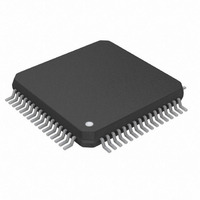DS26521L+ Maxim Integrated Products, DS26521L+ Datasheet - Page 251

DS26521L+
Manufacturer Part Number
DS26521L+
Description
IC TXRX T1/E1/J1 64-LQFP
Manufacturer
Maxim Integrated Products
Type
Line Interface Units (LIUs)r
Datasheet
1.DS26521LN.pdf
(258 pages)
Specifications of DS26521L+
Number Of Drivers/receivers
1/1
Protocol
T1/E1/J1
Voltage - Supply
3.135 V ~ 3.465 V
Mounting Type
Surface Mount
Package / Case
64-LQFP
Product
Framer
Number Of Transceivers
1
Data Rate
44.736 Mbps
Supply Voltage (max)
3.465 V
Supply Voltage (min)
3.135 V
Supply Current (max)
220 mA
Maximum Operating Temperature
+ 85 C
Minimum Operating Temperature
- 40 C
Mounting Style
SMD/SMT
Lead Free Status / RoHS Status
Lead free / RoHS Compliant
- Current page: 251 of 258
- Download datasheet (2Mb)
DS26521 Single T1/E1/J1 Transceiver
13.1
TAP Controller State Machine
The TAP controller is a finite state machine that responds to the logic level at JTMS on the rising edge of JTCLK.
See
Figure
13-2.
13.1.1 Test-Logic-Reset
Upon power-up, the TAP controller is in the Test-Logic-Reset state. The instruction register contains the IDCODE
instruction. All system logic of the device operates normally.
13.1.2 Run-Test-Idle
The Run-Test-Idle is used between scan operations or during specific tests. The instruction register and test
registers remain idle.
13.1.3 Select-DR-Scan
All test registers retain their previous state. With JTMS LOW, a rising edge of JTCLK moves the controller into the
Capture-DR state and initiates a scan sequence. JTMS HIGH during a rising edge on JTCLK moves the controller
to the Select-IR-Scan state.
13.1.4 Capture-DR
Data can be parallel-loaded into the test data registers selected by the current instruction. If the instruction does not
call for a parallel load or the selected register does not allow parallel loads, the test register remains at its current
value. On the rising edge of JTCLK, the controller goes to the Shift-DR state if JTMS is LOW or it goes to the Exit1-
DR state if JTMS is HIGH.
13.1.5 Shift-DR
The test data register selected by the current instruction is connected between JTDI and JTDO and shifts data one
stage towards its serial output on each rising edge of JTCLK. If a test register selected by the current instruction is
not placed in the serial path, it maintains its previous state.
13.1.6 Exit1-DR
While in this state, a rising edge on JTCLK puts the controller in the Update-DR state, which terminates the
scanning process, if JTMS is HIGH. A rising edge on JTCLK with JTMS LOW puts the controller in the Pause-DR
state.
13.1.7 Pause-DR
Shifting of the test registers is halted while in this state. All test registers selected by the current instruction retain
their previous state. The controller remains in this state while JTMS is LOW. A rising edge on JTCLK with JTMS
HIGH puts the controller in the Exit2-DR state.
13.1.8 Exit2-DR
A rising edge on JTCLK with JTMS HIGH while in this state puts the controller in the Update-DR state and
terminates the scanning process. A rising edge on JTCLK with JTMS LOW enters the Shift-DR state.
13.1.9 Update-DR
A falling edge on JTCLK while in the Update-DR state latches the data from the shift register path of the test
registers into the data output latches. This prevents changes at the parallel output due to changes in the shift
register.
13.1.10 Select-IR-Scan
All test registers retain their previous state. The instruction register remains unchanged during this state. With
JTMS LOW, a rising edge on JTCLK moves the controller into the Capture-IR state and initiates a scan sequence
for the instruction register. JTMS HIGH during a rising edge on JTCLK puts the controller back into the Test-Logic-
Reset state.
251 of 258
Related parts for DS26521L+
Image
Part Number
Description
Manufacturer
Datasheet
Request
R

Part Number:
Description:
MAX7528KCWPMaxim Integrated Products [CMOS Dual 8-Bit Buffered Multiplying DACs]
Manufacturer:
Maxim Integrated Products
Datasheet:

Part Number:
Description:
Single +5V, fully integrated, 1.25Gbps laser diode driver.
Manufacturer:
Maxim Integrated Products
Datasheet:

Part Number:
Description:
Single +5V, fully integrated, 155Mbps laser diode driver.
Manufacturer:
Maxim Integrated Products
Datasheet:

Part Number:
Description:
VRD11/VRD10, K8 Rev F 2/3/4-Phase PWM Controllers with Integrated Dual MOSFET Drivers
Manufacturer:
Maxim Integrated Products
Datasheet:

Part Number:
Description:
Highly Integrated Level 2 SMBus Battery Chargers
Manufacturer:
Maxim Integrated Products
Datasheet:

Part Number:
Description:
Current Monitor and Accumulator with Integrated Sense Resistor; ; Temperature Range: -40°C to +85°C
Manufacturer:
Maxim Integrated Products

Part Number:
Description:
TSSOP 14/A�/RS-485 Transceivers with Integrated 100O/120O Termination Resis
Manufacturer:
Maxim Integrated Products

Part Number:
Description:
TSSOP 14/A�/RS-485 Transceivers with Integrated 100O/120O Termination Resis
Manufacturer:
Maxim Integrated Products

Part Number:
Description:
QFN 16/A�/AC-DC and DC-DC Peak-Current-Mode Converters with Integrated Step
Manufacturer:
Maxim Integrated Products

Part Number:
Description:
TDFN/A/65V, 1A, 600KHZ, SYNCHRONOUS STEP-DOWN REGULATOR WITH INTEGRATED SWI
Manufacturer:
Maxim Integrated Products

Part Number:
Description:
Integrated Temperature Controller f
Manufacturer:
Maxim Integrated Products

Part Number:
Description:
SOT23-6/I�/45MHz to 650MHz, Integrated IF VCOs with Differential Output
Manufacturer:
Maxim Integrated Products

Part Number:
Description:
SOT23-6/I�/45MHz to 650MHz, Integrated IF VCOs with Differential Output
Manufacturer:
Maxim Integrated Products

Part Number:
Description:
EVALUATION KIT/2.4GHZ TO 2.5GHZ 802.11G/B RF TRANSCEIVER WITH INTEGRATED PA
Manufacturer:
Maxim Integrated Products

Part Number:
Description:
QFN/E/DUAL PCIE/SATA HIGH SPEED SWITCH WITH INTEGRATED BIAS RESISTOR
Manufacturer:
Maxim Integrated Products
Datasheet:








